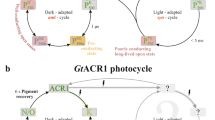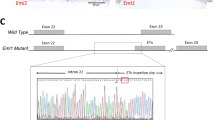Abstract
The peak change in membrane conductance of vertebrate photoreceptors in response to the isomerization of a single photopigment has been estimated from recordings of membrane potential to be about 8 pS in rods1 and 6 pS in cones2. For rods the estimate has been largely confirmed by Yau et al.3 by directly recording membrane current responses of rod outer segments to single photoisomerizations. However, no similar measurements have been reported for cone outer segments. Here, we report on direct recordings of membrane currents of single cone outer segments using an extracellular patch electrode. The technique was similar to that described by Yau et al.3 for toad rods. We have measured dark currents of up to 40 pA, and calculate that the conductance change resulting from a single photoisomerization is less than 1 pS.
This is a preview of subscription content, access via your institution
Access options
Subscribe to this journal
Receive 51 print issues and online access
$199.00 per year
only $3.90 per issue
Buy this article
- Purchase on Springer Link
- Instant access to full article PDF
Prices may be subject to local taxes which are calculated during checkout
Similar content being viewed by others
References
Schwartz, E. A. J. Physiol., Lond. 272, 217–246 (1977).
Baylor, D. A., Hodgkin, A. L. & Lamb, T. D. J. Physiol., Lond. 242, 685–727 (1974).
Yau, K-W., Lamb, T. D. & Baylor, D. A. Nature 269, 78–80 (1977).
Brown, J. E. & Pinto, L. H. J. Physiol., Lond. 236, 575–591 (1974).
Liebman, P. A. in Handbook of Sensory Physiology Vol. VII, Pt 1 (ed. Darnell, H. J. A.) 481–528 (Springer, New York, 1972).
Ebrey, T. D. & Honig, B. Vision Res. 17, 147–151 (1977).
Lasansky, A. & Marchiafava, P. L. J. Physiol., Lond. 236, 171–191 (1974).
Yoshikami, S. & Hagins, W. A. Ann. N. Y. Acad. Sci. 307, 545–561 (1978).
Lamb, T. D. & Simon, E. J. J. Physiol., Lond. 272, 435–468 (1977).
Baylor, D. A. & Fuortes, M. G. F. J. Physiol., Lond. 207, 77–97 (1970).
Bader, D. R., MacLeish, P. R. & Schwartz, E. A. J. Physiol., Lond. 296, 1–26 (1979).
Detwiler, P. B. & Hodgkin, A. L. J. Physiol., Lond. 291, 75–100 (1979).
Normann, R. A. & Perlman, I. J. Physiol., London. 286, 491–507 (1979).
Baylor, D. A., Matthews, G. & Yau, K-W. J. Physiol., Lond. (in the press).
Baylor, D. A. & Hodgkin, A. L. J. Physiol., Lond. 234, 163–198 (1973).
Author information
Authors and Affiliations
Rights and permissions
About this article
Cite this article
Schnapf, J., McBurney, R. Light-induced changes in membrane current in cone outer segments of tiger salamander and turtle. Nature 287, 239–241 (1980). https://doi.org/10.1038/287239a0
Received:
Accepted:
Issue Date:
DOI: https://doi.org/10.1038/287239a0
This article is cited by
-
Phototransduction in cones: An inverse problem in enzyme kinetics
Bulletin of Mathematical Biology (1989)
-
Cyclic GMP increases photocurrent and light sensitivity of retinal cones
Nature (1985)
-
Cyclic GMP-sensitive conductance in outer segment membrane of catfish cones
Nature (1985)
-
Localization of the Na-K pump in turtle retina
Journal of Neurocytology (1985)
Comments
By submitting a comment you agree to abide by our Terms and Community Guidelines. If you find something abusive or that does not comply with our terms or guidelines please flag it as inappropriate.



